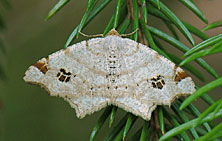Press release 2013-09-30 at 9:04

Macaria notata © Eino Ylönen
Press release by SYKE, University of Eastern Finland and Kainuu Centre for Economic Development, Transport and the Environment
The majority of Finnish moth species fly weeks earlier in warm vs. cool years, but thermal sensitivity varies among populations. In particular, the more poleward community of moths is less physiologically responsive to warming, which partly buffers these systems from effects of more rapid warming in higher latitudes. This was the result of a collaborative study carried out by the University of Eastern Finland, the Finnish Environment Institute, Kainuu Centre for Economic Development, Transport and the Environment, and Dartmouth College. The study was just published in Global Change Biology.
Climate warming is influencing natural systems by altering the annual timing of biological events. Earlier studies have shown that the most important physiological mechanisms controlling insect phenology are temperature, photoperiod or combination of both. The researchers compared the fit of competing models of physiological controls on flight phenology to 334 moth species and found that in most species the timing of flight was strongly controlled by temperatures.
The study was based on 20 years of data of the nation-wide Finnish Moth Monitoring Scheme Nocturna, coordinated by the Finnish environmental administration. The scheme, which monitors populations of night-active moths in over 40 sites in forested habitats across the country, was launched in 1993, and more than 6 million moth individuals have been identified by volunteer observers and stored in a database. The project is rather unique world-wide, as schemes monitoring night-active insects that correspond in spatial coverage and continuation exist in only two other countries.
For further information, please contact:
Dr. Anu Valtonen, University of Eastern Finland, Department of Biology, tel. +358-50-4424403, firstname.lastname@uef.fi
Dr. Juha Pöyry, Finnish Environment institute SYKE, tel. +358-40-148665, firstname.lastname@environment.fi (Information on the moth monitoring scheme)
MSc. Reima Leinonen, Kainuu Centre for Economic Development, Transport and the Environment (ELY Centre), tel. +358-40-5296896, firstname.lastname@ely-keskus.fi (Information on the moth monitoring scheme)
Prof. Matthew P. Ayres, Department of Biological Sciences, Dartmouth College, USA, matthew.p.ayres(at)dartmouth.edu
Research article
Valtonen A, Leinonen R, Pöyry J, Roininen H, Tuomela J, Ayres MP (2013) Is climate warming more consequential towards poles? The phenology of Lepidoptera in Finland. Global Change Biology
Photos for media
According to the study, flight periods of moths are predicted to shift towards earlier timing with warming climate more in southern than in northern Finland. The picture presents Peacock moth (Macaria notata), a common geometrid moth across southern and central parts of Finland. Photo: Eino Ylönen
Photo: Eino Ylönen
Photo: Eino Ylönen